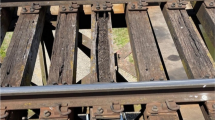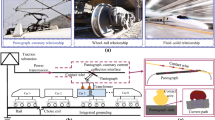Abstract
This paper investigates the vertical deflection on ballasted railway tracks from a set of cases of railway track typologies which differ in six track parameters: embankment height, ballast thickness, sleeper spacing, rail pad stiffness, Young’s modulus of the embankment material and the load applied to the structure. Finite element method has been the tool to assess the structural combinations and the results provided by linear and nonlinear analyses have been contrasted. Then, a new formulation for the deflection estimation in terms of the aforementioned parameters is presented based on a multiple regression model. The results provided by this formulation have been compared to those obtained from the classic Zimmermann theory. Finally, a stress analysis has been performed to complete the study and better understand the global behaviour of the railway structure. This article pretends to improve the design process and construction of ballasted railway tracks by means of proposing a formulation which estimates the track deflection to obtain the optimum track stiffness.
Similar content being viewed by others
References
G. A. Hunt, Review the effect of track stiffness on track performance, RSSB, Research Project T372 (2005).
M. Burrow, P. Teixeira, T. Dahlberg and E. Berggen, Track stiffness considerations for high speed railway lines, Railway transportation: policies, technology and Perspectives, Ed. N. P. Scott, Nova Publishers (2009).
F. Meissonmier, EUROBALT II european research for an optimised ballasted track, Final Report Technical Part — 7S/001127/E1/DC (2000).
UIC, Project I/03/U/283 — Ballastless Track — Version 2005-08-02, Draft -Vertical Elasticity of Ballastless Track (2005).
M. X. D. Li and E. G. Berggren, A study of the effect of global track stiffness and its variations on track performance: Simulation and measurement, Proceedings of the Institution of Mechanical Engineers, Part F: Journal of Rail and Rapid Transit (2010) 224–375.
A. López Pita, P. Fonseca Teixeira and F. Robuste, High speed and track deterioration: the role of vertical stiffness of the track, Proceedings of the Institution of Mechanical Engineers, Part F: Journal of Rail and Rapid Transit, 218(1) (2004) 31–40.
C. Esveld, Modern railway track, 2nd edition, MRT Productions, Zaltbommel, The Netherlands (2001).
P. F. Teixeira, Contribución a la reducción de los costes de mantenimiento de las vías de alta velocidad mediante la optimización de su rigidez vertical, PhD Thesis, Universidad Politecnica de Cataluña (2003).
A. López Pita, Nuevos criterios en el dimensionamiento de vías férreas, Revista de Obras Públicas, 124(3147) (1977) 571–580.
A. López Pita, Un nuevo método para la determinación de la capa de balasto, AIT 13 (1976) 77–89.
I. Gallego Giner and A. Lopez Pita, Numerical simulation of embankment-structure transition design, Proceedings of the Institution of Mechanical Engineers, Part F: Journal of Rail and Rapid Transit, 223(4) (2009) 331–343.
A. López Pita and C. Oteo Mazo, Análisis de la deformabilidad vertical de una vía férrea mediante el método de elementos finitos, AIT, 15(4) (1977) 33–40.
V. Profillidis, La voie ferrée et sa foundation, Modelisation mathématique, PhD Thesis, Ecole Nationale des Ponts et Chausées, Paris (1983).
ORE committee D-117, Adaptation optimal de la voie classique au traffic de l’avenir, Rapport no 27, Comportament des structures d’assise de la voie sous changes répétées, E.T.F., Paris (1983).
M. P. N. Burrow, D. Bowness and G. S. Ghataora, A comparison of railway track foundation design methods, Proceedings of the Institution of Mechanical Engineers, Part F: Journal of Rail and Rapid Transit, 221(1) (2007) 1–12.
Ministerio de fomento/Secretaría de estado de Infraestructuras y Transportes, Recomendaciones para el proyecto de plataformas ferroviarias, Centro de publicaciones, Madrid (1999).
UIC. Earthworks and track bed construction for railway lines. UIC 719, International Union of Railways, Paris, France (1984).
R. Romero Villafranca and L. Zúnica Ramajo, Métodos estadísticos en ingeniería, Editorial U.P.V., Valencia (2004).
E. Tutumluer, D. N. Little and D. H. Kim, Validated model for predicting field performance of aggregate base courses. Geomaterials 2003 - Soils, Geology, and Foundations, 1837 (2003) 41–49.
Y. Qiu, N. D. Dennis and R. P. Elliott, Design criteria for permanent deformation of subgrade soils in flexible pavements for low-volume roads. Soils and Foundation, 40(1) (2000) 1–10.
S. Helwany, J. Dyer and J. Leidy, Finite-element analyses of flexible pavements, Journal of Transportation Engineering, 124(5) (1998) 491–499.
S. S. Radampola, N. Gurung, T. McSweeney and M. Dhanasekar, Evaluation of the properties of railway capping layer soil, Computers and Geotechnics, 35(5) (2008) 719–28.
D. C. Drucker and W. Prager, Soil mechanics and plastic analysis or limit design, Quarterly of Applied Mathematics, 10 (1952) 157–165.
A. López Pita, Infraestructuras ferroviarias, Ediciones U.P.C., Barcelona (2006).
Author information
Authors and Affiliations
Corresponding author
Additional information
Recommended by Associate Editor Kyeongsik Woo
Julia Real is a Civil Engineer. She studied at Polytechnic University of Valencia. Nowadays she is a professor at the School of Civil Engineering at this university. Julia Real leads a research group specialized in railway engineering, which is enshrined in the Department of Engineering and Infrastructures of Transportation. She has collaborated on 25 research projects in association with private companies over the last years. Furthermore she has published several papers, as “Determination of rail vertical profile through inertial methods” and “A procedure for the evaluation of vibrations induced by the passing of a train and its application to real railway traffic”.
Rights and permissions
About this article
Cite this article
Real, J.I., Gómez, L., Montalbán, L. et al. Study of the influence of geometrical and mechanical parameters on ballasted railway tracks design. J Mech Sci Technol 26, 2837–2844 (2012). https://doi.org/10.1007/s12206-012-0734-7
Received:
Revised:
Accepted:
Published:
Issue Date:
DOI: https://doi.org/10.1007/s12206-012-0734-7




